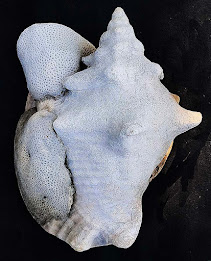Three examples of "shell trumpets":
1) Four views (apertural, dorsal, right side, and top) of the same specimen of the “Helmet shell” = Cassis cornuta (Linné, 1758), length 22 cm, width 15.5 cm; three views: apertural, dorsal, and right side.
2) Three views of the same specimen of “Atlantic Triton shell” = Charonia variegata (Lamarck, 1816), length 15 cm, width 6 cm; three views: apertural, dorsal, and right side. from southeast Florida, West Indies. Note: Except for being smaller in size, this species looks very similar to Charonia tritonis (Linné, 1758) from coral reefs in the Indo-Pacific area.
3) “Queen conch” = Strombus gigas from southeastern United States and West Indies; length 22.8 cm, width 20.3 cm, right side 12.7 cm. Note: There are two colonial corals (lumpy objects) attached along one side of this shell.
Go online to YouTube.com, if you want to see videos describing the process of making a shell trumpet and how to make the associated musical notes. These videos are interesting and educational. One thing they commonly forget to mention is to be sure to wear a mask when cutting through any shell, especially when the cutting is done via a drill or electric grinder. The dust is toxic.
Antonowitz (1972) wrote an article describing shell ochestras comprised of groups of people in New Guinea , Germany, and elsewhere in the world assembling for the purpose of making “conch”
music.
References Cited:
Antonowitz, W. Hear the shells! Of Sea and Shore, Summer 1972, pp. 67–68.










No comments:
Post a Comment